
Ticks are parasitic arachnids that are part of the mite superorder Parasitiformes. Adult ticks are approximately 3 to 5 mm in length depending on age, sex, species, and "fullness". Ticks are external parasites, living by feeding on the blood of mammals, birds, and sometimes reptiles and amphibians. The timing of the origin of ticks is uncertain, though the oldest known tick fossils are from the Cretaceous period, around 100 million years old. Ticks are widely distributed around the world, especially in warm, humid climates.
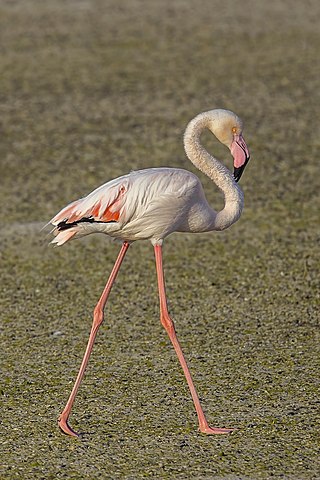
The greater flamingo is the most widespread and largest species of the flamingo family. It is found in Africa, the Indian subcontinent, the Middle East, and in southern Europe.
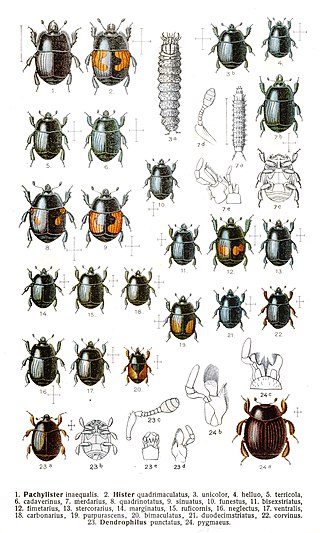
Histeridae is a family of beetles commonly known as clown beetles or Hister beetles. This very diverse group of beetles contains 3,900 species found worldwide. They can be easily identified by their shortened elytra that leaves two of the seven tergites exposed, and their geniculate (elbowed) antennae with clubbed ends. These predatory feeders are most active at night and will fake death if they feel threatened. This family of beetles will occupy almost any kind of niche throughout the world. Hister beetles have proved useful during forensic investigations to help in time of death estimation. Also, certain species are used in the control of livestock pests that infest dung and to control houseflies. Because they are predacious and will even eat other Hister beetles, they must be isolated when collected.

The willow beauty is a moth of the family Geometridae. It is a common species of Europe and adjacent regions. While it is found widely throughout Scandinavian countries, which have a maritime climate, it is absent from parts of the former USSR which are at the same latitude but have a more continental climate.

The mottled beauty is a moth of the family Geometridae. The species was first described by Carl Linnaeus in his 1758 10th edition of Systema Naturae.
The Alcis or Alci were a pair of divine young brothers worshipped by the Naharvali, an ancient Germanic tribe from Central Europe. The Alcis are solely attested by Roman historian and senator Tacitus in his ethnography Germania, written around 98 AD.

The family Oedemeridae is a cosmopolitan group of beetles commonly known as false blister beetles, though some recent authors have coined the name pollen-feeding beetles. There are some 100 genera and 1,500 species in the family, mostly associated with rotting wood as larvae, though adults are quite common on flowers. The family was erected by Pierre André Latreille in 1810.

Cleridae are a family of beetles of the superfamily Cleroidea. They are commonly known as checkered beetles. The family Cleridae has a worldwide distribution, and a variety of habitats and feeding preferences.
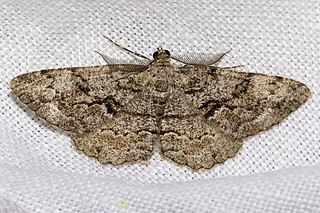
Peribatodes secundaria, the feathered beauty, is a moth of the family Geometridae. The species was first described by Michael Denis and Ignaz Schiffermüller in 1775. It can be found in Europe.
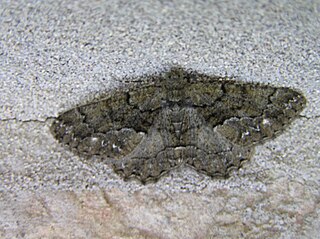
Peribatodes ilicaria, the Lydd beauty, is a moth of the family Geometridae. The species was first described by Carl Geyer in 1833. It can be found in Europe and North Africa.

Alcis is a genus of moths in the family Geometridae described by John Curtis in 1826.

The Trictenotomidae are a small family of beetles in the superfamily Tenebrionoidea, containing fifteen species in two genera. Most species are found in the Oriental realm where they live in montane forest habitats. The family is considered, based on larval characters as well as sequence-based studies, to be closely related to the Salpingidae.
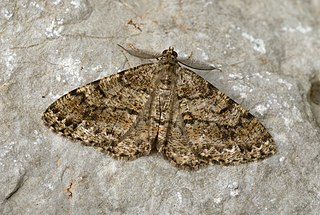
Deileptenia ribeata, the satin beauty, is a moth of the family Geometridae. The species was first described by Carl Alexander Clerck in 1759. It is found from Ireland, east through central Europe to Russia and Japan.
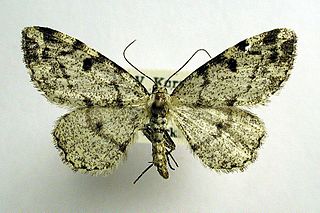
Alcis jubata, the dotted carpet, is a moth of the family Geometridae. The species was first described by Carl Peter Thunberg in 1788. It is found in central Europe, Scandinavia and northern Italy.
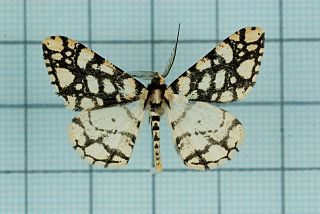
Alcis maculata is a moth of the family Geometridae. It is found from Tibet and the Himalaya to Taiwan, Thailand, Sumatra and Borneo.

Alcis scortea is a moth of the family Geometridae. It is found in Taiwan.

Max Joseph Bastelberger was a German medical doctor and entomologist. He was specialized on geometrid moths and described 351 new taxa.
Eupithecia bastelbergeri is a moth in the family Geometridae. It is found in Kazakhstan, Kyrghyzstan, Russia, Iran and Turkey.
Haematobosca alcis, the moose fly, is a species of blood-feeding muscidae in the family Muscidae. It is found in Europe.The moose fly, Haematobosca alcis (Snow) is abundant in Yellowstone National Park

Hans Hirschke, sometimes Hanns, was an Austrian entomologist who specialised in Lepidoptera. He was first a linen weaver in Brno, then a gardener's apprentice. In 1899, he was Head of the Exchange Office Vienna and a Member of the Entomological Association of Vienna. Hans Hirschke described Alcis bastelbergeri and Phengaris rebeli in Jber. Wien. ent. Ver.


















